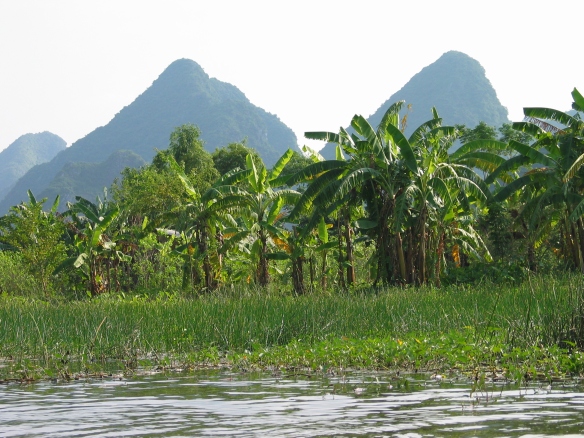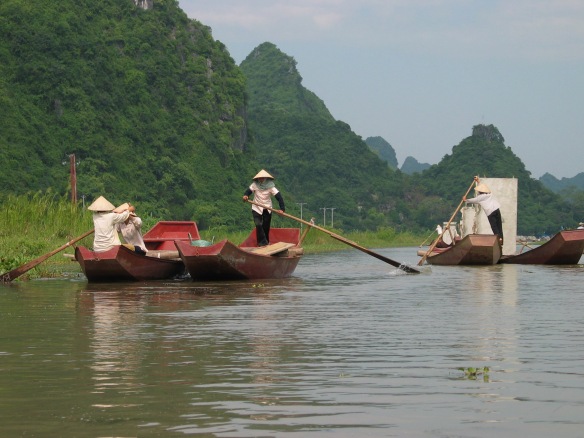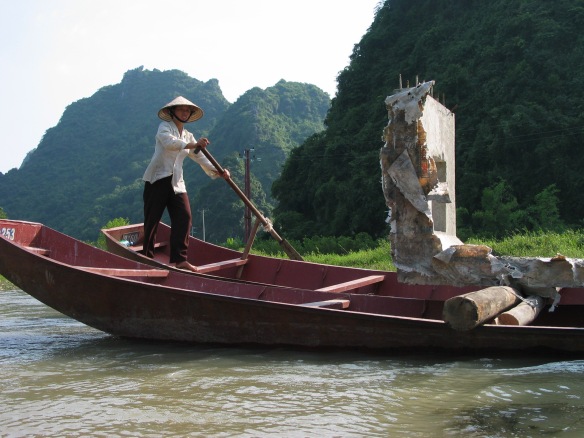NOTE: Today marks the beginning of the 5 day festival of the Vietnamese goddess Bà Chúa Xứ. In her honor I am reprinting my original post about her cult. —Jadi
To see the Mekong Delta on our own by boat proved complicated and required more time than we had. We signed on instead for a tour. We were lucky: only a young couple from Holland had signed up as well.
Travel by boat we did! We took long boats, short boats, boats powered by motors or by human arms. We visited floating markets and stumbled into a tourism promotion festival going on in Chau Doc.
For me the highlight was the festival for Bà Chúa Xứ, the Lady of the Realm on the border to Cambodia. The shrine to Bà Chúa Xứ houses the most important cult in southern Vietnam.
We had the really good luck to visit Bà Chúa Xứ’s temple during the holiest period of the year. Her three-day festival starts at the beginning of the rainy season on the twenty-third day of the fourth lunar month.
The Lady of the Realm protects female entepreneurs (important in a country like Vietnam where women play a major role in small family businesses). Bà Chúa Xứ’s cult has a fascinating belief in both fecundity and the capacity of the goddess to multiply all that she touches — including money.
If you invoke Bà Chúa Xứ’s help, you must make a pilgrimage to thank your benefactress for her assistance. (She is remorseless to those who betray her favor!) Traditionally men need to spend 9 years making an annual pilgrimage, and 7 years are required of women.
In the courtyard before her temple, spirit money is burned in huge vats.
I wanted to make an offering inside the temple and decided to brave the crowds.
I joined the slow moving throngs and we inched our way forward. All around me pilgrims carried tall flowers,
and men bore platters with decorated sacrifices of whole pigs on their shoulders.
People bought baskets filled with offerings of fruit,
and still others carried lit sticks of incense, held high.
The crowds were so thick that I was concerned someone would set my hair on fire!
Once I was inside the temple I managed to make my way up to Bà Chúa Xứ’s altar. Each day in progressive rituals her image is washed and cleaned. On this day, old women were changing her robes. I was unable to get close enough though, and made my offering later out in the (relatively) less-crowded courtyard.
The goddess originally resided on the top of Sam Mountain; her image is popularly thought to have grown from the stones of the landscape.
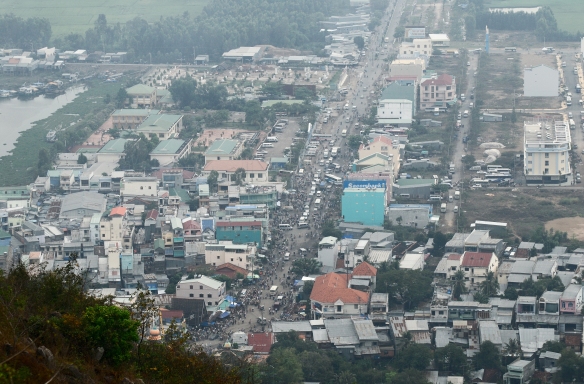
She wished to be worshipped and caused the locals to move her statue down to Vĩnh Tế village, where her temple still stands today.
I was surprised and moved to realize that her image had mass and strength rather than simple beauty. Some reports state that her statue is a female Shiva (Khmer). Other sources equate her with the queen Thien Y A Na (Cham), the goddess Tin Hau (Chinese), and the Lady Buddha (India). Bà Chúa Xứ is also named The Black Lady, and I see a likeness to Christianity’s Black Madonna.
Bà Chúa Xứ is a powerful deity protecting and bestowing prosperity on her people in the Mekong Delta. In such a fertile area it makes sense to believe in a benevolent, generous goddess.
NOTES: © Jadi Campbell. All photos © Uwe Hartmann. More pictures from our trips to Vietnam and of Uwe’s photography may be viewed at viewpics.de.
Click here for my author page to learn more about my books and me.





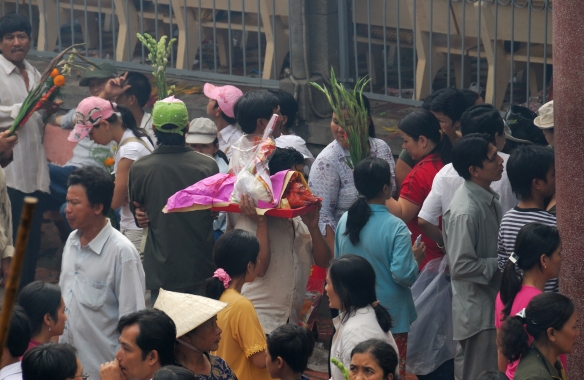
















 This 3-day festival celebrates the start of the rainy season by shooting rockets off into the heavens. [1] Teams compete for awards with home made rockets. HOME MADE.
This 3-day festival celebrates the start of the rainy season by shooting rockets off into the heavens. [1] Teams compete for awards with home made rockets. HOME MADE.



 But what a terrific way to mark the change of seasons: throw a village party, give out some prizes (and these were significant: our guide told us a new house and a water buffalo were among the prizes to be awarded), and shoot off some fireworks. Just make sure that they’re home made, by a team of you and your friends.
But what a terrific way to mark the change of seasons: throw a village party, give out some prizes (and these were significant: our guide told us a new house and a water buffalo were among the prizes to be awarded), and shoot off some fireworks. Just make sure that they’re home made, by a team of you and your friends.





 We were in Laos and Vientiane for the first time, and only had a couple of days there. So we booked a car and driver and a guide, and left the city for a day. On the way back, we drove down a road filled with stands selling food and drinks. “It’s a rocket festival,” our guide exclaimed. “Would you like to stop and see it?”
We were in Laos and Vientiane for the first time, and only had a couple of days there. So we booked a car and driver and a guide, and left the city for a day. On the way back, we drove down a road filled with stands selling food and drinks. “It’s a rocket festival,” our guide exclaimed. “Would you like to stop and see it?”

 What really drew our interest were the large numbers of men in dresses and skirts, wearing make-up. It was still the afternoon, and most of them were already hammered.
What really drew our interest were the large numbers of men in dresses and skirts, wearing make-up. It was still the afternoon, and most of them were already hammered.

 Laos’s most important religious festival opens with a parade led by monks and government officials, accompanied by musicians in ethnic costumes.
Laos’s most important religious festival opens with a parade led by monks and government officials, accompanied by musicians in ethnic costumes.








 The festival brings everyone together, regardless of ethnic group or social standing. The procession shows solidarity among communities as people from all walks of life take part in the festival. Everyone dresses in their best clothes, and people from all over the country attend. Groups across Laos try to bring at least one wax castle to the stupa. The stupa itself is the country’s most important religious edifice, believed to contain a sacred relic of the Buddha.
The festival brings everyone together, regardless of ethnic group or social standing. The procession shows solidarity among communities as people from all walks of life take part in the festival. Everyone dresses in their best clothes, and people from all over the country attend. Groups across Laos try to bring at least one wax castle to the stupa. The stupa itself is the country’s most important religious edifice, believed to contain a sacred relic of the Buddha.
 We spent a long time on the grounds, quietly watching the comings and goings. People laugh and talk and play music as they make their offerings, but the solemnity of the procession made me sorry I didn’t have on a skirt or dress, or pay to rent a sarong for the event. Tourists are welcomed but there is nothing touristy about this sacred ritual. It was an overwhelmingly, intensely Laotian celebration. As always: I feel honored and lucky that Uwe and I were there for that full moon, and that we continue to get to witness the wonders of this precious world.
We spent a long time on the grounds, quietly watching the comings and goings. People laugh and talk and play music as they make their offerings, but the solemnity of the procession made me sorry I didn’t have on a skirt or dress, or pay to rent a sarong for the event. Tourists are welcomed but there is nothing touristy about this sacred ritual. It was an overwhelmingly, intensely Laotian celebration. As always: I feel honored and lucky that Uwe and I were there for that full moon, and that we continue to get to witness the wonders of this precious world.
 NOTES: “November 28, 2012 Wax Castle Procession” Vientiane Times, The First National English Language Newspaper
NOTES: “November 28, 2012 Wax Castle Procession” Vientiane Times, The First National English Language Newspaper The That Luang Festival – Part 1
The That Luang Festival – Part 1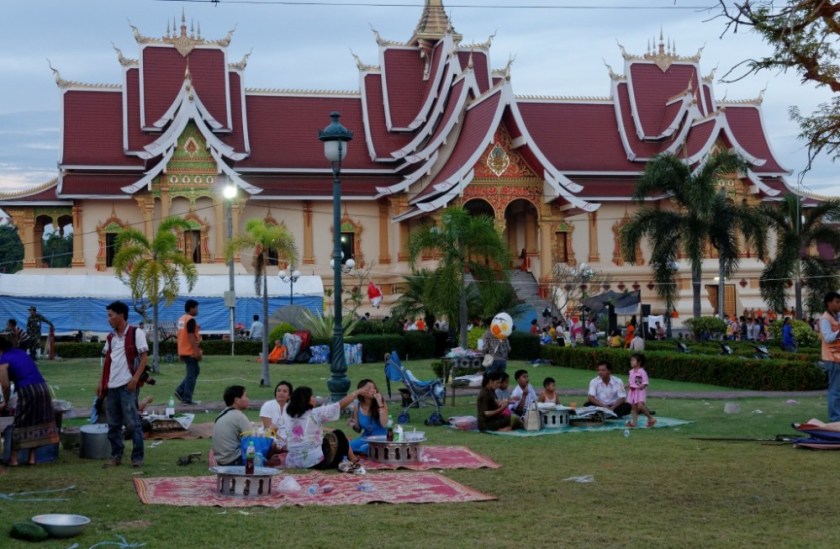


 The festival is a holiday honoring Buddha at the That Luang stupa, Laos’s most sacred religious site. [1] Traditionally, the festival occurs during the full moon of the twelfth lunar month (November).
The festival is a holiday honoring Buddha at the That Luang stupa, Laos’s most sacred religious site. [1] Traditionally, the festival occurs during the full moon of the twelfth lunar month (November).






 Part 2 will post next week.
Part 2 will post next week. This is a brand new feature for this blog: I’m transcribing selected entries from my old travel journals. Currently I’m working on a batch of new posts set in Laos. I hauled out the journal I kept on our first visit to make sure that my memories match up with the facts. My descriptions from that trip are raw. I use a travel diary to record first impressions and get down the details to go over later (like now, years later). I’ve decided to post some of them here for your amusement. — Jadi
This is a brand new feature for this blog: I’m transcribing selected entries from my old travel journals. Currently I’m working on a batch of new posts set in Laos. I hauled out the journal I kept on our first visit to make sure that my memories match up with the facts. My descriptions from that trip are raw. I use a travel diary to record first impressions and get down the details to go over later (like now, years later). I’ve decided to post some of them here for your amusement. — Jadi A 1,000-year-old site we visited with our guide on yesterday’s tour:
A 1,000-year-old site we visited with our guide on yesterday’s tour: Buddhas in the Angkor Wat style carved out of boulders in the jungle. And, not twenty feet away, a spirit altar by a tall tree. [1]
Buddhas in the Angkor Wat style carved out of boulders in the jungle. And, not twenty feet away, a spirit altar by a tall tree. [1] No one’s allowed to build anything on or near the site. But the locals come there for ceremonies and celebrations. It had a rather hushed and holy air as we stood on the jungle (forest) floor in the welter of the afternoon heat at Vang Sang. An elephant graveyard was once found nearby!
No one’s allowed to build anything on or near the site. But the locals come there for ceremonies and celebrations. It had a rather hushed and holy air as we stood on the jungle (forest) floor in the welter of the afternoon heat at Vang Sang. An elephant graveyard was once found nearby!


 The buildings all high on stilts for the rainy times. We had my favorite meal so far in this trip: a soup with fresh Chinese vegetables and tofu and vermicelli noodles – it may be the freshest ingredients in a soup of this kind I can remember. And a lake fish grilled whole with garlic and ginger and lemon grass and cilantro; and it was all just too delicious for words.
The buildings all high on stilts for the rainy times. We had my favorite meal so far in this trip: a soup with fresh Chinese vegetables and tofu and vermicelli noodles – it may be the freshest ingredients in a soup of this kind I can remember. And a lake fish grilled whole with garlic and ginger and lemon grass and cilantro; and it was all just too delicious for words.


 The boatwomen at Bến Đục (Duc Pier) make enough money to support their families, and are chosen by lottery.
The boatwomen at Bến Đục (Duc Pier) make enough money to support their families, and are chosen by lottery.